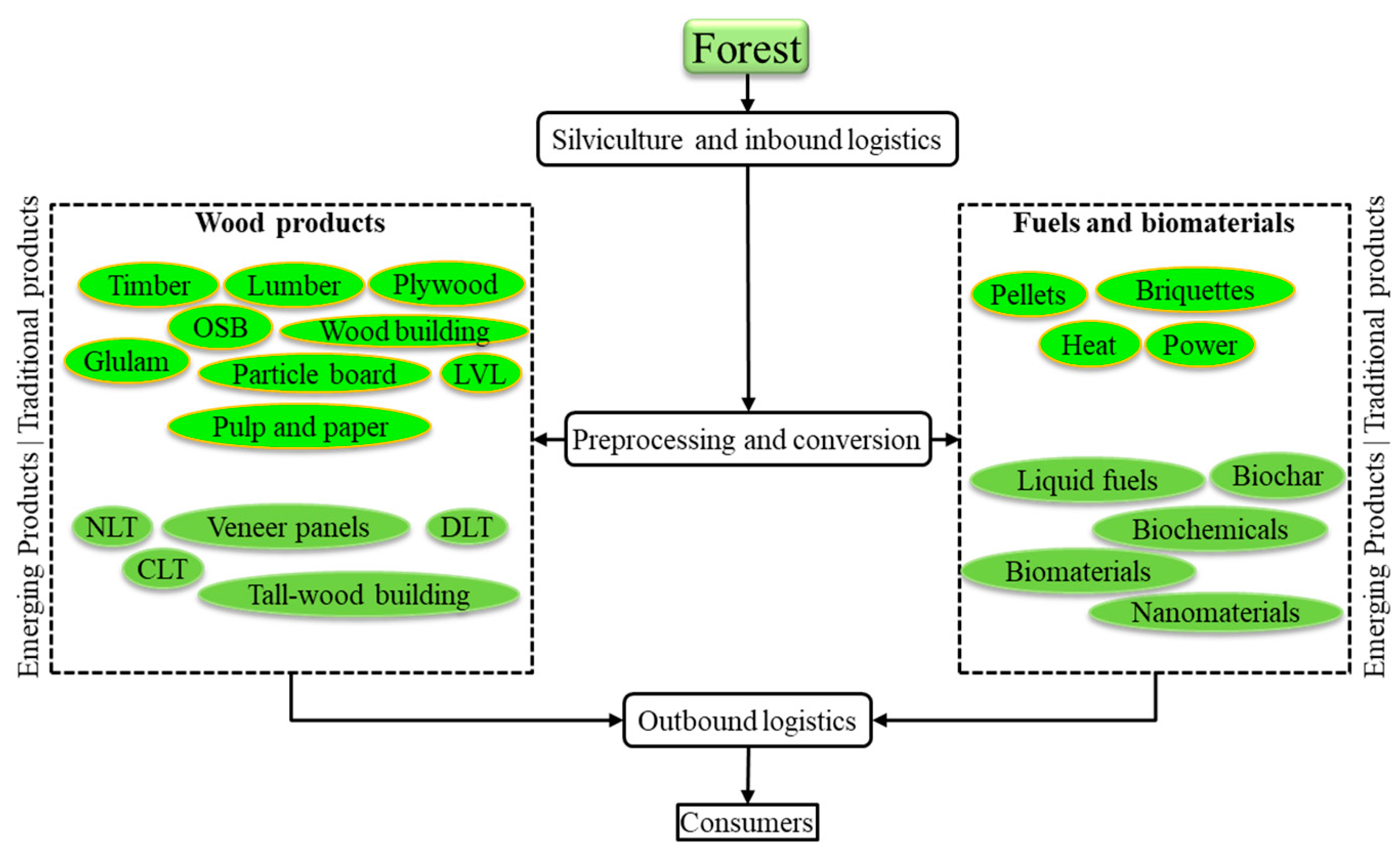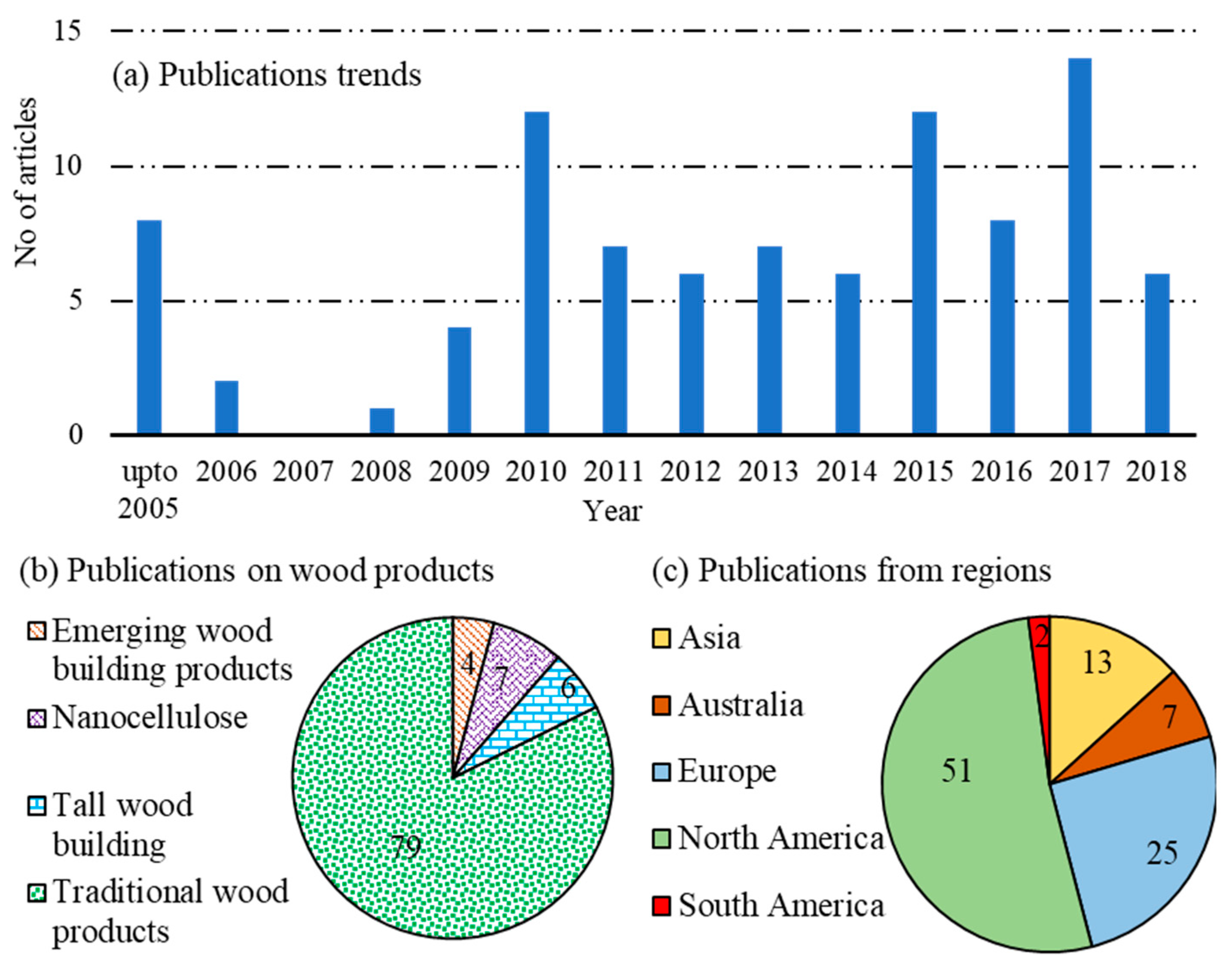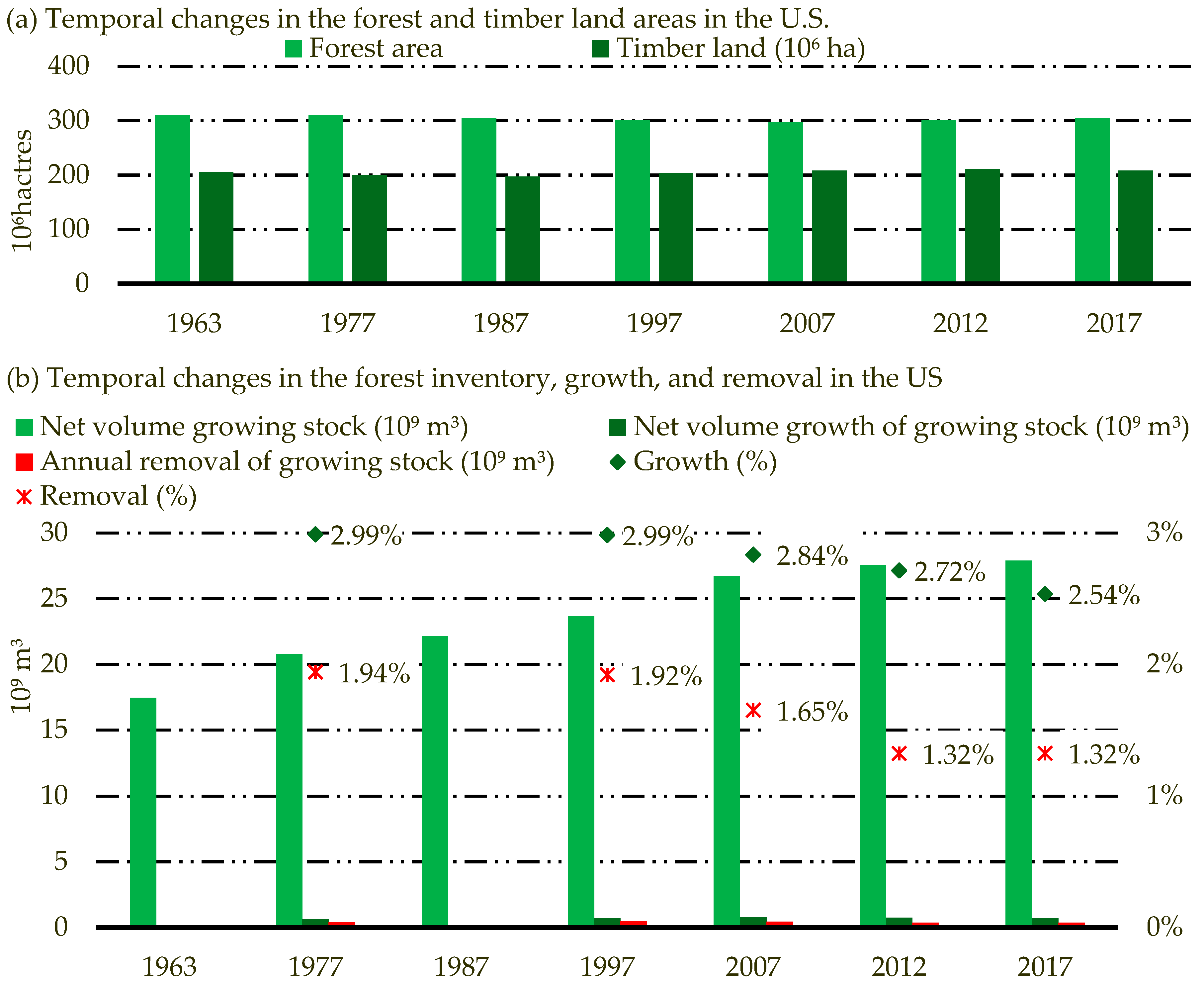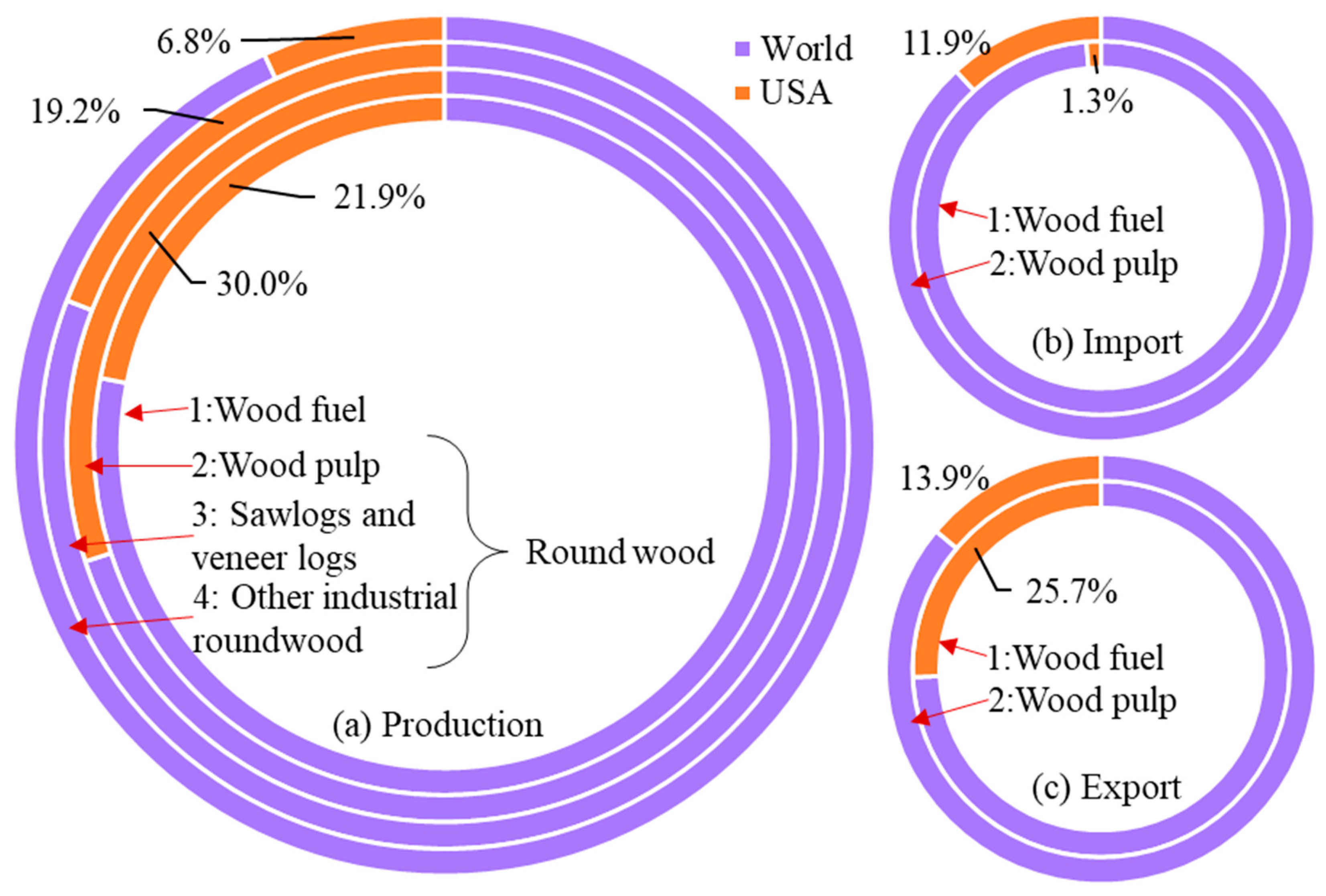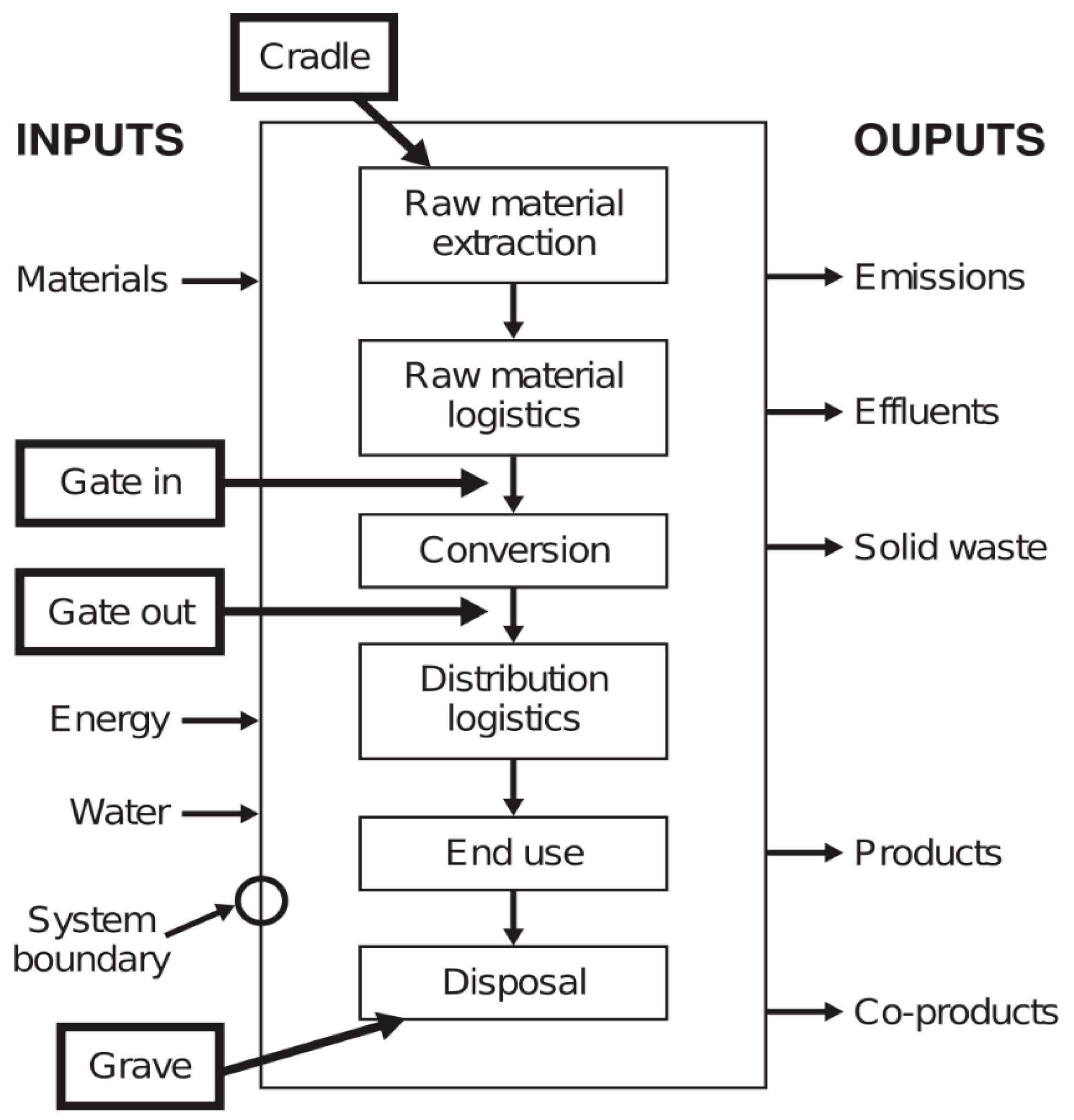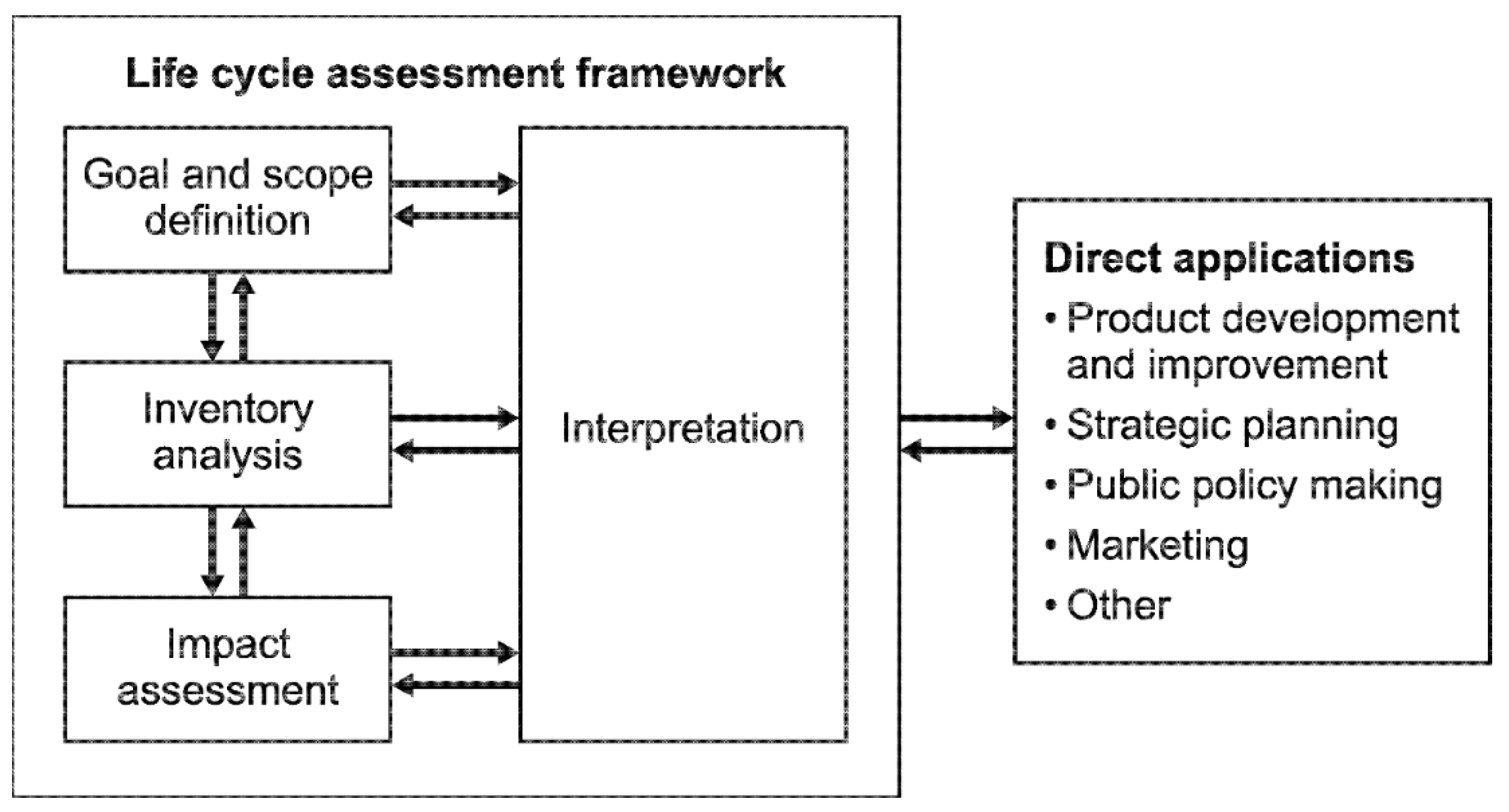The field of LCA has become increasingly active for documenting environmental performance. Initially, building products were evaluated in order to construct and populate whole building tools. As the green building movement grew over the last couple of decades, emerging wood building products were developed along with other forest-based products which used LCA in their product development. This section highlights the linkage of building product and building systems and the importance of providing LCA results on both, especially for newer mass timber building systems. Although there are several studies that show comparisons between building products such as Bergman et al. (2014), ideally, taking a building system approach to gauge the effectiveness of building with wood instead of other materials gives greater context on what building material to use from an environmental performance standpoint.
4.2.1. Traditional Wood Building Products
Traditional wood products have been used for centuries to build infrastructures such as buildings, ships, and bridges. This section focuses on forest-based products used in the building sector for both structural and nonstructural purposes. Although the word ‘traditional’ is used to describe this section, engineered as well as solid wood products are considered. Many countries including Scandinavian countries, Japan, Canada, and the United States have a long history of building with wood [
43]. Wood products tend to have a lower environmental footprint, especially related to greenhouse gas (GHG) emissions, than other non-wood products [
44,
45,
46].
Residential and commercial buildings consume about 40% of all energy used in the U.S. [
47]. Although most energy is used during building occupation (i.e., after construction), there is increased awareness of decreasing the embodied energy, the amount of energy used in the production of building material, as part of the overall aim of lowering the environmental footprint of a building. This endeavor is becoming increasingly critical as buildings are being built to higher energy standards thus reducing their operating energy. Green construction practices have advanced markedly during the past 40 years in an effort to lower energy consumption, improve the total building performance and move toward more sustainable practices. In practice, green building began as a series of prescriptions that experts assumed were the most critical to moving construction toward sustainability goals. Green building certifications have now expanded to include LCA, which provides insight on how to improve energy and material efficiency throughout the material production and building construction and operation while lowering overall environmental impacts throughout the building’s whole life cycle [
41].
Classifying building materials that possess positive environmental attributes is one result of the increased attention given to green building practices. These practices may include using building materials with lower environmental impacts as well as reusing or reducing the use of building materials capable of doing the same function. The green building materials market is expected to reach nearly
$240 billion globally in 2022 from
$192 billion in 2016 [
48]. In addition, building codes and standards such as the International Green Construction Code (IgCC) are implementing performance-based decision making based on scientific approaches including LCA [
7]. There are many other green building certification systems in the United States, with the most recognized being Leadership in Energy and Environmental Design (LEED) along with ICC-700 National Green Building Standard, Green Globes, IgCC, California Green Construction Code (CalGreen) and ASHRAE 189.1 [
49]. These green building certification systems are based on various parameters including building product LCA data as an objective scientific basis for showing the relative environmental benefit or “greenness,” of projects built using these certification systems. This trend signifies a shift away from prescriptive-based to performance-based certification systems. In expectation of the adoption of such policies and their market implications, a number of industries have initiated efforts to develop LCA data for their products [
50,
51,
52,
53]. Furthermore, whole-building LCA tools, such as the Athena Impact Estimator for Buildings, are a necessary part of finding a building’s environmental impact and are gradually becoming part of green building certification systems [
54]. Developing metrics to measure sustainability is part of the green building process (
Table 1).
There is substantial literature on traditional wood building products (
Table 1 and
Table 2). More than 100 articles were found. However, many (32) were not included in this study for various reasons including languages other than English and different wood product categories. In addition, there are numerous original U.S. LCI studies (no impact method categories reported) developed through CORRIM that eventually became CORRIM LCA reports to generate LCA-based ecolabels called environmental product declarations (EPDs) [
63,
64,
65]. These wood building EPDs are helping to drive green building construction and are provided on a North American basis (i.e., combining U.S. and Canadian LCA data). All EPDs require periodic updating along with the underlying LCA data according to ISO 14025 [
54]. Therefore, LCAs and EPDs for all wood-producing regions in North America are now in the process of being revised. Furthermore, many U.S. LCAs reported were found in both CORRIM reports and peer-reviewed journal articles. In this study, the journal articles took precedence (
Table 2).
4.2.2. Emerging Wood Building Products
Innovative engineered wood building products (mass timber) are being developed to expand the use of traditional wood products, increase the efficiency of wood resource use and improve properties for specific applications. Advances in wood products design such as improved fire resistance and structural integrity help to promote the use of wood materials in taller wood buildings, expanding the application of wood beyond that for single-family houses. Today, the increased interest in green buildings has really pushed for the massive use of wood materials and more developments in the wood products sector [
83]. Wood is preferred over nonwood structural products because of aesthetics, cost-effectiveness, environmental benefits and increasing sustainability interests [
84]. The emerging wood building products can be used for mid- to high-rise wood building constructions because of structural capability and improved properties. Major emerging products from the forest products industries include CLT, NLT, massive veneer panels and DLT, which are designed to replace traditional concrete and steel structural materials in multistory buildings in which traditional wood building products cannot be used.
Traditional uses of wood in light-framed wood houses, engineered wood (I-joist or plywood, OSB, etc.) are mainly used as post and beams, along with dimensional lumber. The emerging structural wood products are mainly characterized by their use for floor, wall and roof structures. Among these products, CLT has been studied the most. The method to make CLT and similar perpendicular engineered wood products dates back to the early 20th century in the United States [
85]. However, it was in Europe during the early 1990s where CLT started to be used commercially with its application as walls, floors, and roofs in residential and commercial buildings. During the past few decades, CLT has become widely accepted as a structural wood product alternative to concrete and steel, particularly in Europe [
86]. It is a solid structural wood panel made of 3, 5, 7 or 9 layers of solid-sawn lumber or structural composite lumber glued together and oriented at right angles to one another [
87,
88]. Layers of kiln-dried lumber are typically glued with PUR (polyurethane), MUF (melamine-urea-formaldehyde-resin) or emulsion-polymer-isocyanate (EPI) resin. In addition to its advanced properties of greater rigidity and stability, CLT provides better fire resistance compared with traditional wood products, because it chars slowly [
89,
90,
91] through its large mass. It also has good seismic performance resulting from its dimensional stability and rigidity [
89,
92,
93,
94]. This makes CLT a viable alternative to steel and concrete in the building industry.
Among the currently available emerging wood products, CLT manufacturing has been studied with LCA focused on investigating environmental impacts. Within the past five years, a limited number of studies evaluated the life cycle impacts associated with the CLT supply chain. CLT is a relatively new commercially produced product particularly in the United States and limited manufacturers are in the field. Therefore, North American CLT manufacturing data are limited [
95,
96,
97]. Mass timber buildings constructed with CLT and glulam have also been investigated for environmental benefits using LCA tools [
98,
99,
100,
101], which is covered in the following mass timber building LCA section. The cradle-to-gate CLT product is typically composed of resource extraction, lumber (primary) manufacturing and CLT (secondary) manufacturing. The first stage, resource extraction, covers the forest operations from tree growth to logging and including transportation. The CLT manufacturing stage includes lumber preparation, adhesive application, layup assembly pressing, and panel finishing. The lumber preparation at the CLT manufacture includes lumber sorting, planing, drying and cutting to length. The lumber is also dried to 12% moisture content (MC) on a dry basis (db) to aid in the gluing process, which is lower than the drying level of commodity lumber (15% MC dry basis). The LCA studies used primary data collected through the surveys from the CLT manufacturing and also used secondary data from the literature for other stages [
95,
96,
97].
The cradle-to-gate LCA studies showed that the CLT manufacturing stage contributed the most to the global warming impact compared with other traditional wood products [
95,
96,
97]. Two studies were based on CLT production in the U.S. (
Table 3). [
97] investigated environmental impacts associated with CLT production in Oregon, U.S. Another U.S.-based study [
96], performed a region-specific cradle-to-gate LCA for CLT with data representing technology available in the western part of Washington State. This study particularly investigated the effect of logistics, location of materials and their transportation and different wood species mix on the resulting life cycle impacts. Sensitivity analyses were performed by focusing on commercial softwood species in Washington State including Sitka spruce (
Picea sitchensis), Douglas-fir (
Pseudotsuga menziesii) and western hemlock (
Tsuga heterophylla). Wood species used and transportation had a notable effect on overall global warming (GW), where up to 14% reduction in GW can be achieved by reducing the transportation distances [
96]. The study reported that up to a 29% decrease in GW impact can be achieved using a lighter species such as Sitka spruce compared with the baseline scenario (Douglas-fir and western hemlock mix). Another study investigated the effect of logistics, focusing on Japanese logistics [
102]. That study revealed that, for shorter distances, ocean freight transportation resulted in lower GW impact compared with truck transportation. The scenario analysis showed that importing CLT from Austria resulted in a 20% increase in GW impact. In the analysis, 60% of the total GW impact was allocated to transportation.
Wood products processing results in various coproducts, which makes allocation necessary [
103]. Mass allocation is commonly used in forest product LCAs, although recent studies began reporting results using both mass and economic allocation methods. For the CLT supply chain, the majority of the impact categories in the studies reported results for both economic and mass allocation showed a notable difference between the results [
95,
97].
Table 4 shows that the US-based studies reported higher GW impact compared with a Canadian study. This resulted from the higher GW impact of lumber and CLT manufacturing life cycle stages and was partially caused by electrical grid composition [
95,
97]. In addition, U.S. lumber production reported higher cumulative energy demand (CED) compared with the Canadian study. [
71] noted that this may have been caused by lower resin use reported in Canadian CLT and the use of different wood species.
4.2.3. Mass Timber Buildings
For hundreds of years, wood buildings have been built with heavy timber construction although a small minority of the built environment especially in recent years. New advances in wood science and engineering for mass timber products and associated building systems are resulting in major changes in the built environment. These emerging mass timber products can replace heavy timbers and are designed for buildings with multiple stories. Structural elements of mass timber buildings are made from mass timber products such as CLT, DLT, NLT, and glulam. Glulam is a more traditional wood building product but its use in mass timber buildings is common in conjunction with CLT, DLT, and NLT. Other traditional wood building products can be utilized in these building systems as well but in much smaller quantities. The use of CLT as a building material started in Europe in the 1990s and in the last decade, many CLT mass timber buildings have been built worldwide because of its positive environmental benefits and potential local economic impacts [
92,
104]. There are sustainability assessment tools specifically designed for whole building LCA analysis. These include the Athena Impact Estimator for Buildings, Tally, BEES (Building for Environmental and Economic Sustainability) and BIRDS (Building Industry Reporting and Design for Sustainability) [
54,
105,
106,
107]. These tools include relevant material databases that can be used for whole building LCA analysis. Although LCA studies on CLT mass timber buildings are rare, as shown in
Table 5, only the most relevant references with detailed building information and environmental impacts were included in this review.
Among these studies, all CLT buildings exhibited better environmental performance such as lower GW compared with their corresponding building alternatives, although different study periods and system boundaries were applied [
98,
101,
108,
109,
110,
111]. Except for the research conducted by Liu et al. [
101], which used cradle-to-gate LCA, all others conducted cradle-to-grave LCAs to provide more information. System boundaries for building products and building systems are detailed in ISO 21930 [
55] and EN 15978 [
112], which comprise modules A1–A3 (production), A4–A5 (construction), B1–B7 (use), C1–C4 (end-of-life) and D (optional information beyond the system boundary). Module D points to the possible net benefits from reuse, recycling and any energy recovery outside the system boundaries and the effects are conducted through scenario analyses. Cradle-to-gate building LCAs cover modules A1–A3 while cradle-to-grave LCAs cover modules A1–A5, B1–B7 and C1–C4 with any exclusions noted. Only the research by Reference [
108] includes module D for materials recycling, in which the total GW impact was reduced by 2% under the assumption of 40% wood materials recycling rate. However, this number might be too conservative compared with the 60% to 80% concrete and steel recycling rates. Currently, although module D is optional for LCA studies, it should be the point of interest for the forest products industry. Building LCA study periods range from 50 to 100 years to reflect stakeholders’ expectations, in which the use stage (module B) usually causes the most environmental impacts [mainly because of the building’s operating energy consumption (B6)]. For example, two studies from Athena Sustainable Materials Institute showed that the GW ratio (use stage versus total cradle-to-grave) was about 92% and 89% for a study period of 50 and 100 years, respectively [
110,
111]. However, as buildings become increasingly energy efficient, their embodied energy becomes more substantial. This trend will likely to continue for the built environment as green building practices become part of normal construction and business practices. The materials transportation (A4) usually is not a significant contributor to total environmental impacts. However, the use of local materials especially CLT should be encouraged to avoid the environmental burden. All CLT mass timber buildings in
Table 5 used local CLT manufacturers except the study by Reference [
108], which used European CLT and imported to Australia, which could significantly increase the environmental impacts, although the report did not show this information explicitly. It is expected that more LCA studies on mass timber buildings will come with the increasing interest in CLT and other mass timber use in the building industry sector. For both emerging mass timber products and building systems, there are areas of uncertainty. Being somewhat newer product and building systems, the actual versus expected service life effects the basis for selecting a functional unit for cradle-to-grave LCA analyses. Consequentially, a lower service life results in higher impacts for the system studied. Also, estimating end-of-life impacts is uncertain as well although there has been researched to quantify how wood and wood products are handled.
4.2.4. Advanced Materials (Nanomaterials or Nanocellulose)
Nanomaterials and nanocellulose comprised of nanosized (1–100 nm) cellulosic fibrils or crystals are obtained generally from plants. This article covers only plant-derived nanomaterials. Nanocellulose is considered a novel advanced biomaterial but the global economic impacts of nanocellulose are projected to reach
$600 billion by 2020, which is highly unlikely given the current commercial product output [
10]. There are different types of nanomaterials produced from cellulose, which is the world’s most abundant polymer. Cellulose makes up about 38% to 49% of dry wood with the remainder being made up of hemicellulose (15–26%) and lignin (18–35%), along with small amounts of extraneous materials.
Cellulose fibers in the wood cell wall create an amorphous matrix with lignin hemicellulose, proteins, and other organic substances. Cellulose nanomaterials are differentiated [
25] as (i) nanostructured materials [cellulose microcrystal (CMC, width: 10–15 μm, L/D < 2) and cellulose microfibril (CMF, width: 10–100 nm, length: 0.5–50 μm)] and (ii) cellulose nanofiber [cellulose nanofibril (CNF, width: 5–30 nm, L/D > 50) and cellulose nanocrystal (CNC, width: 3–10 nm, L/D > 5)] based on the appearance and preparation method. CNFs can be extracted from plant cell walls either by mechanical shearing (such as grinding, cryo-crushing (mechanical fibrillation) and high-pressure homogenization) or thermal-mechanical (steam explosion, aqueous counter collision) or physio-chemical (high-temperature extrusion) or a combination of chemical pre-treatments followed by mechanical routes (hydrolysis—high-intensity ultrasonication, electrospinning, etc.). The production of CNCs is more complicated and involves multiple steps such as mechanical size reduction, purification, and bleaching of cellulose, chemical pre-treatment and mechanical/ ultrasound treatment. Acid hydrolysis can be used to produce CNCs without mechanical treatment but it degrades cellulose resulting in lower nanocellulose yield and poor thermal stability. To improve the thermal stability of CNCs, solid and gaseous acid hydrolysis has been used in place of liquid acids. Because nanocellulose is a newer forest-based product, investigating its production along the supply chain can provide insights into its environmental performance, influence which potential manufacturing process is chosen for commercial production and give insights into how to improve the product in future production.
The production of nanocellulose is a very energy-intensive process. Additionally, the aggregation of disintegrated fibers is very common during the process of defibrillation. Furthermore, noncellulosic components such as hemicellulose and lignin create a hindrance by blocking the cellulose from chemical intrusion [
25,
113]. Pre-treatment alters structural organization, crystallinity, and polymorphism of cellulose (frees the individual fibers), which is favorable in nanocellulose production, thus it can reduce the energy requirement by a factor of ten. Therefore, various chemical and mechanical pre-treatment methods had been proposed based on the input feedstocks such as pulping process, bleaching and alkali treatments, enzymatic treatment and oxidation (i.e., oxidation with 2,2,6,6-tetramethylpiperidine-1-oxyl (TEMPO) reagent) [
114,
115], carboxymethylation [
115] and acetylation of the fibers [
115]. Moreover, microwave-assisted pre-treatment, e-beam irradiation, chemical swelling, and extrusion pre-treatments have been proposed recently for use in the CNC production process [
25]. As previously mentioned, using the LCA method now can be a critical driver.
There are only a handful of studies that used LCA to quantify the environmental impacts of nanocellulose. The cradle-to-gate LCA studies included raw material extraction, logistics, and manufacturing stages of products. The LCA studies of nanocellulose were performed using either primary data from lab-scale/pilot-scale experiments or from secondary data. The primary materials to produce nanocellulose were either from pulp or directly from woody biomass (
Table 6). However, most studies consider pulp (kraft pulp or sulfite pulp) as feedstock to produce nanocellulose. Nanocellulose production from woody biomass requires a pulping process to dissolve lignin and hemicellulose [
116,
117].
Production of nanocellulose (without pre-treatment) is an energy-intensive process, where a large amount of electricity (~27 kWh/kg of nanocellulose) is consumed to break down the crystalline structure of cellulose and defibrillate individual fibers [
113,
122]. Without pre-treatment of pulp, microfibrillated cellulose (MFC) produced from kraft pulp or sulfite pulp requires about 12 to 70 and 27 kWh/kg of MFC, respectively [
113]. Thermo-mechanical [
116,
117], chemical [
115,
118,
119] and enzymatic [
115,
121] pre-treatments were proposed to pretreat the pulp/woody biomass to help free up the nanofibers and thus reduce the energy required in the process of nanocellulose extraction. The pre-treatment process (carboxymethylation and enzymatic) can drastically reduce the energy requirement of MFC production (0.5–1.5 kWh/kg of MFC) [
113]. Hohenthal et al. [
114] studied nanofibrillated cellulose (NFC) produced from sulfite pulp considering pre-treatments (enzymatic and chemical) and mechanical homogenization from two different geographic locations in Europe, France, and Finland, for its environmental life cycle impacts. Three pathways considered were (i) enzymatic (i.e., endoglucanase) pre-treatment of pulp and refined in a high-pressure homogenizer, (ii) TEMPO oxidation of pulp and refined in a high-pressure homogenizer and (iii) TEMPO oxidation of pulp and refined in a continuous high-energy Cavitron (ARDE Barinco, Inc., Carlstadt, NJ) disperser. Although enzymatic pretreated pulp required more than double the amount of electricity in a high-pressure homogenizer, its water usage was very low, yield of NFC was high (100%) and no chemicals were used. The requirement of electricity in the Cavitron disperser was about 25% compared with a high-pressure homogenizer. Tempo oxidation also requires chemicals such as 2,2,6,6-tetramethylpiperidine-1-oxyl (TEMPO), NaBr, NaClO and NaOH and consumes a large amount of water to wash NFC (lower yield; ~71%), which negatively affects its environmental performance. Both midpoint and endpoint environmental impacts were measured considering a functional unit of 10 g of nanocellulose. GW impact varied from 750 to 3100 kgCO
2e/ton of NFC. The large range was caused by differences in the NFC production locations and concentration of NFC. For example, GW impact of NFC produced in France is half that of NFC produced in Finland because of the difference in the GHG emissions on a kWh basis for the individual country’s electrical grid. This study also estimated other impact factors such as eutrophication, acidification and fossil fuel depletion (
Table 7). Li et al. [
115] performed a cradle-to-gate LCA study for the production of nanocellulose through four comparable chemical-mechanical methods in lab-scale (TEMPO oxidation followed by sonication or homogenization and chloroacetic etherification followed by sonication or homogenization) from kraft (chemical) pulp and impacts are estimated with the Eco-Indicator 99 impact assessment method. This study used similar inputs as Hohenthal et al. [
114] for the TEMPO oxidation except for ethanol for quenching the reaction. The chemicals used in chloroacetic acid etherification were chloroacetic acid, NaOH, isopropanol and ethanol. The large differences in the LCA results between Hohenthal et al. [
114] and Li et al. [
115] (
Table 7) were caused by the differences in the key variables such as type of chemical pulps (sulfite vs kraft) as feedstocks, processing time, concentration, number of passes and power consumption in the fibrillation step. Moreover, the use of ethanol for quenching the reaction and a large amount of electricity use during homogenization in Li et al. [
115] had a large impact on the LCA results. Feedstocks from the various pulping methods can vary the LCIA results and thus additional investigation is required. Pulp production is an energy-intensive process with large environmental impacts. In the Japanese nanocellulose LCA, Sun et al. [
116] and Moon et al. [
117] evaluated CNF production from woody biomass considering combined wet disk milling and mild hot-compressed water (HCW) treatment. In the HCW treatment, the acetyl groups of hemicellulose and water itself act as acids, which dissolve both hemicellulose and lignin in woody biomass [
123]. Sun et al. [
116] assumed a CNF yield of about 80% to 92% of woody biomass and energy usage was much lower than other studies with no chemical inputs. The MiLCA, a Japanese LCA support system—supported by a database, the IDEA (Inventory Database Environmental Analysis) was developed by the National Institute of Advanced Industrial Science and Technology (AIST) and the Japan Environmental Management Association for Industry (JEMAI) [
116]—to perform LCAs. GW impacts of CNF estimated by Sun et al. [
116] and Moon et al. [
117] were 1.2 to 3.7 and 5.7 to 7.6 kgCO
2e/kg of CNF, respectively, which were in the range of results produced by Hohenthal et al. [
114]. Lower GW impact was possibly caused by the use of woody biomass in place of pulp, lower energy usage per production unit, absence of high-energy intensive feedstock chemicals and other inputs and the higher assumed CNF yield.
Arvidsson et al. [
118] performed an LCA of CNF production from four types of pulp considering no pre-treatment and enzymatic and chemical pre-treatments of pulp followed by microfluidization treatment for the extraction of CNF. That study provided a comprehensive and detailed analysis of all inventory used in the production of CNF including inbound logistics of all raw materials. The results (
Table 7) suggested that the CNF production through either no pre-treatment or enzymatic pre-treatment routes have much lower environmental footprints than the chemical pre-treatment route, which consumes large amounts of solvents made from crude oil.
Gu et al. [
119] studied the LCA of CNC produced from bleached kraft pulp through a pilot-scale production plant that used chemical pre-treatment (acid hydrolysis of pulp) followed by ultrafiltration of disintegrated treated pulp (50% CNC yield). The use of chemical (i.e., sodium hydroxide) and electricity had the largest impacts in all categories of environmental footprints of CNC. However, these impacts were much lower than other chemical routes to produce nanocellulose.
The environmental impacts of nanocellulose are lower than other nanomaterials [
25,
115,
122]. Furthermore, adding nanocellulose to parent materials can improve their properties and requires less of the parent materials to achieve the same functionality. For example, the addition of nanocellulose in the raw material composition results in a reduction of 29% of raw material consumption for wet-laid nonwoven material [
114]. Incorporating CNF to paper increased the recyclability of paper from 3 to 7 times, thus reducing the environmental impacts from paper production [
124]. When nanocellulose was applied to wet-laid nonwoven, Hohenthal et al. [
114] estimated a reduction in environmental footprints (~30% lower GW impacts) compared with reference product standard wet-laid nonwoven material. Similarly, Delgado-Aguilar et al. [
124] performed the LCA of incorporating nanocellulose to paper to improve its physical properties and recyclability. In retrospect, nanocellulose production is in its infancy. Therefore, investigating the environmental performance offers a great deal of opportunity in forging the production process with the lowest life cycle environmental impacts while aiding commercial products such as paper products to improve their environmental performance.
